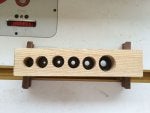Anybody ever tried making their own dowel plate? I've got some accent dowels I want to use to pin a couple mortise and tenon joints and don't really want to drop $50 on a Lie-Nielson one. I snagged a piece of 1/4" cold rolled out of the scrap bin at work and figured I'd use that to start with. I'm guessing on top of drilling the size hole you need you would also break the leading edge with a chamfer or would that just compress the wood instead of shearing it off? Any suggestions or does somebody have a dowel plate that would take a picture of the hole details for me?
Thanks.
Thanks.










